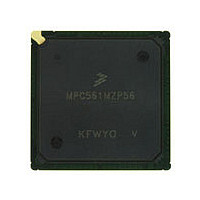MPC561MZP56 Freescale, MPC561MZP56 Datasheet - Page 313

MPC561MZP56
Manufacturer Part Number
MPC561MZP56
Description
Manufacturer
Freescale
Datasheet
1.MPC561MZP56.pdf
(1420 pages)
Specifications of MPC561MZP56
Cpu Family
MPC56x
Device Core
PowerPC
Device Core Size
32b
Frequency (max)
56MHz
Interface Type
QSPI/SCI/SPI/UART
Total Internal Ram Size
32KB
# I/os (max)
56
Number Of Timers - General Purpose
22
Operating Supply Voltage (typ)
2.6/5V
Operating Supply Voltage (max)
2.7/5.25V
Operating Supply Voltage (min)
2.5/4.75V
On-chip Adc
2(32-chx10-bit)
Instruction Set Architecture
RISC
Operating Temp Range
-40C to 125C
Operating Temperature Classification
Automotive
Mounting
Surface Mount
Pin Count
388
Package Type
BGA
Program Memory Type
ROMLess
Program Memory Size
Not Required
Lead Free Status / RoHS Status
Not Compliant
Available stocks
Company
Part Number
Manufacturer
Quantity
Price
Company:
Part Number:
MPC561MZP56
Manufacturer:
Freescale Semiconductor
Quantity:
10 000
Company:
Part Number:
MPC561MZP56R2
Manufacturer:
Freescale Semiconductor
Quantity:
10 000
- Current page: 313 of 1420
- Download datasheet (11Mb)
The general system clock frequency can be switched between different values. The highest operational
frequency can be achieved when the system clock frequency is determined by DFNH (CSRC bit in the
PLPRCR is cleared) and DFNH = 0 (division by one). The general system clock can be operated at a low
frequency (gear mode) or a high frequency. The DFNL bits in SCCR define the low frequency. The DFNH
bits in SCCR define the high frequency.
The frequency of the general system clock can be changed dynamically with the system clock control
register (SCCR), as shown in
The frequency of the general system clock can be changed “on the fly” by software. The user may simply
cause the general system clock to switch to its low frequency. However, in some applications, there is a
need for a high frequency during certain periods. Interrupt routines, for example, may require more
performance than the low frequency operation provides, but must consume less power than in maximum
frequency operation. The MPC561/MPC563 provides a method to automatically switch between low and
high frequency operation whenever one of the following conditions exists:
When neither of these conditions exists and the CSRC bit in PLPRCR is set, the general system clock
switches automatically back to the low frequency.
Abrupt changes in the divide ratio can cause linear changes in the operating currents of the
MPC561/MPC563.
When the multiplication factor (PLPRCR[MF]) for the PLL is changed, the PLL stops all internal clocks
until the PLL adjusts to the new frequency. This includes stopping the clock to the watchdog timer,
therefore SWT cannot reset the system during this period.
When the clock stops, the current consumed by the device from VDD will fall; it will then rise sharply
when the PLL turns on the PLL output clocks at the new frequency. These abrupt changes in the divide
ratio can cause linear changes in the operating currents of the device. Insure that the proper power supply
filtering is available to handle changes instantaneously. The gear modes (DFNH and DFNL) can be used
to temporarily decrease the system frequency to minimize the demand on the power supply when the MF
or DIVF multiply/divide ratio is changed.
When the general system clock is divided, its duty cycle is changed. One phase remains the same (for
example, 12.5 ns at 40 MHz) while the other becomes longer.
Freescale Semiconductor
•
•
VCO/2 (e.g., 40 MHz)
There is a pending interrupt from the interrupt controller. This option is maskable by the PRQEN
bit in the SCCR.
The (POW) bit in the MSR is clear in normal operation. This option is maskable by the PRQEN
bit in the SCCR.
O
Figure
DFNH Divider
DFNL Divider
Figure 8-5. General System Clocks Select
MPC561/MPC563 Reference Manual, Rev. 1.2
8-5.
DFNH
DFNL
O
O
Normal
Low Power
O
General System Clock
Clocks and Power Control
8-11
Related parts for MPC561MZP56
Image
Part Number
Description
Manufacturer
Datasheet
Request
R

Part Number:
Description:
MPC5 1K0 5%
Manufacturer:
TE Connectivity
Datasheet:

Part Number:
Description:
MPC5 500R 5%
Manufacturer:
TE Connectivity
Datasheet:

Part Number:
Description:
MPC5 5K0 5%
Manufacturer:
Tyco Electronics
Datasheet:

Part Number:
Description:
MPC5 5R0 5%
Manufacturer:
Tyco Electronics
Datasheet:

Part Number:
Description:
MPC5 50K 5%
Manufacturer:
Tyco Electronics
Datasheet:

Part Number:
Description:
MPC5 1R0 5%
Manufacturer:
Tyco Electronics
Datasheet:

Part Number:
Description:
TOWER ELEVATOR BOARDS HARDWARE
Manufacturer:
Freescale Semiconductor
Datasheet:

Part Number:
Description:
TOWER SERIAL I/O HARDWARE
Manufacturer:
Freescale Semiconductor
Datasheet:

Part Number:
Description:
LCD MODULE FOR TWR SYSTEM
Manufacturer:
Freescale Semiconductor
Datasheet:

Part Number:
Description:
DAUGHTER LCD WVGA I.MX51
Manufacturer:
Freescale Semiconductor
Datasheet:

Part Number:
Description:
TOWER SYSTEM BOARD MPC5125
Manufacturer:
Freescale Semiconductor
Datasheet:












